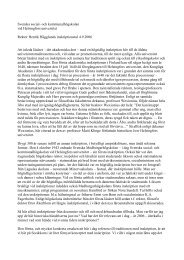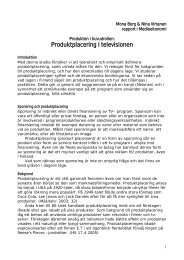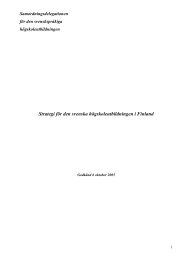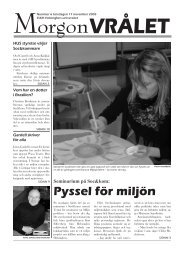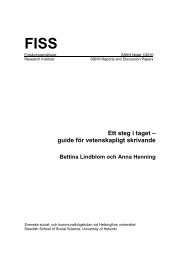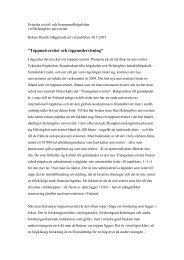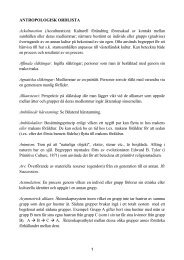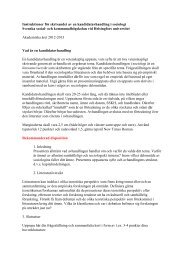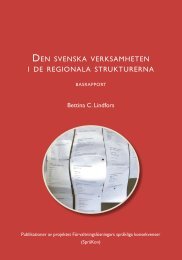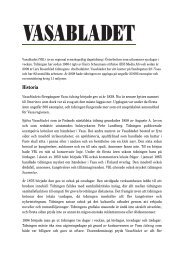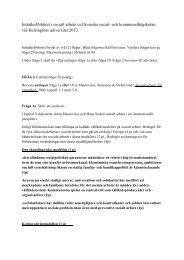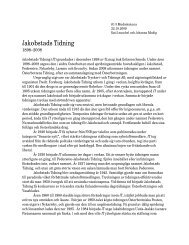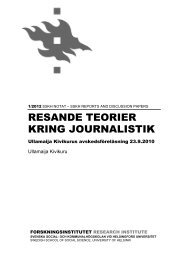FISS - Svenska social - Helsinki.fi
FISS - Svenska social - Helsinki.fi
FISS - Svenska social - Helsinki.fi
Create successful ePaper yourself
Turn your PDF publications into a flip-book with our unique Google optimized e-Paper software.
<strong>FISS</strong><br />
Forskningsinstitutet SSKH Notat<br />
Research Institute SSKH Reports and Discussion Papers 7/2005<br />
The future and changing economies<br />
of rural areas<br />
Project Report D18 of RURBAN,<br />
Minutes meeting study areas<br />
<strong>Svenska</strong> <strong>social</strong>- och kommunalhögskolan vid Helsingfors universitet<br />
Swedish School of Social Science, University of <strong>Helsinki</strong><br />
Dan Koivulaakso
Forskningsinstitutet vid <strong>Svenska</strong> <strong>social</strong>- och kommunalhögskolan vid Helsingfors<br />
universitet (<strong>FISS</strong>) publicerar i Notat-serien föredrag och diskussionsinlägg,<br />
bakgrundsmaterial, preliminära rapporter samt projektbeskrivningar av allmänt<br />
vetenskapligt intresse eller avsedda för en mera avgränsad publik. Syftet med serien<br />
är att sprida kunskap om den pågående verksamheten samt att bidra till forskarnas<br />
möjlighet att få respons i ett tidigt skede av forskningsprocessen. Forskningsinstitutet<br />
vill betona bidragens preliminära karaktär; de kan senare omarbetas och ingå i andra<br />
publikationer.<br />
Högskolans två andra publikationsserier, Skrifter samt Meddelanden innehåller<br />
forskningsresultat av mera slutgiltig karaktär.<br />
The Research Institute of the Swedish School of Social Science at the University of<br />
<strong>Helsinki</strong> (<strong>FISS</strong>) has established this new series in order to show the ongoing activity<br />
of the Institute and to provide researchers with an early feedback to their ideas and<br />
activities. The series consists of discussion papers, research outlines and preliminary<br />
reports of general interest or of interest to speci<strong>fi</strong>c groups. The preliminary nature of<br />
the contributions is emphasized. Some contributions may appear later in a revised<br />
form in other publications.<br />
The publications in the two other series of the School, Skrifter, and Meddelanden,<br />
contain more <strong>fi</strong>nal research results.<br />
Tel +358-9-191 28400, fax +358-9-191 28485<br />
Internet: http://sockom.helsinki.<strong>fi</strong><br />
Address: <strong>Svenska</strong> <strong>social</strong>- och kommunalhögskolan vid Helsingfors universitet<br />
PB 16, FIN-00014 Helsingfors universitet<br />
Visiting address: Pohjoinen Hesperiankatu 15 A, 6. floor<br />
FIN-00260 <strong>Helsinki</strong> 26
SSKH Reports and Discussion Papers<br />
RESEARCH INSTITUTE<br />
Swedish School of Social Science,<br />
University of <strong>Helsinki</strong><br />
7/2005
The future and changing economies of rural areas<br />
Project Report D18 of RURBAN, Minutes meeting study areas<br />
Swedish School of Social Science,<br />
University of <strong>Helsinki</strong>
ISBN 952-10-2536-0 (pdf)<br />
ISBN 952-10-2535-2<br />
ISSN 1457-1250<br />
<strong>Helsinki</strong> 2005<br />
Swedish School of Social Science,<br />
University of <strong>Helsinki</strong>
Table of Contents<br />
1.<br />
1.2<br />
2.<br />
2.1<br />
2.2<br />
3.<br />
3.1<br />
3.2<br />
3.3<br />
4.<br />
4.1<br />
4.2<br />
4.3<br />
4.4<br />
5.<br />
Foreword<br />
Introduction<br />
Key Questions<br />
What is a “new rural landscape”?<br />
Late modern nomadism<br />
Results from M- and T-regions in the RURBAN-project<br />
Does urban pressure present an opportunity or a threat?<br />
Key issues and own experiences<br />
Larger structures and theory<br />
Administration and the future<br />
How are RGS (rural goods and services) valued?<br />
Introduction to new rural economies<br />
Leisure living<br />
A scenario for future development in the T-region<br />
A scenario for future development in the M-region<br />
Future<br />
References and list of previous Finnish RURBAN-reports<br />
5<br />
7<br />
8<br />
10<br />
11<br />
12<br />
13<br />
13<br />
15<br />
16<br />
18<br />
18<br />
18<br />
19<br />
22<br />
25<br />
26
Foreword: the RURBAN-project and the context of this report<br />
The research project Building New Relationships in Rural Areas under Urban Pressure<br />
(RURBAN) analyses the relationships between rural and urban actors in order to assess<br />
their role in enhancing the diversity of rural landscapes. Since agriculture and forestry are<br />
the most important land uses in European rural areas, the project pays attention to their role<br />
in safeguarding the green landscape and in providing RGS. The most important RGS<br />
within this context are <strong>fi</strong>rst and second houses, tourism and gastronomy with agri-food<br />
marketing.<br />
The research project RURBAN is a 3-year-project (2002-2005). The project is a<br />
partnership between the Agricultural Economics Research Institute in the Netherlands<br />
(coordinator), the University of <strong>Helsinki</strong>, the University of Paris, the Hungarian Academy<br />
of Sciences and the University of Valencia. The research project has been funded by the<br />
European Commission within the Fifth Framework Programme (QLK5-CT-2002-01696).<br />
The Ministry of Agriculture, Nature and Food quality in the Netherlands funded 50 percent<br />
of the budget for the Agricultural Economics Research Institute.<br />
Research objectives<br />
1. The green rural landscape in a rural-urban context, in particular:<br />
perception of urban pressure, rural-urban relations, RGS and<br />
compensation payments;<br />
2. Demand for RGS, in particular: identi<strong>fi</strong>cation of trends and<br />
motives to demand RGS and willingness to pay for RGS and the<br />
green landscape;<br />
3. Identi<strong>fi</strong>cation of strategies by intermediate actors, in particular:<br />
to organise RGS and compensation payments to enhance RGS;<br />
4. Propensity to provide RGS, in particular: identi<strong>fi</strong>cation of trends<br />
and motives to supply RGS and to preserve the green landscape;<br />
5. New relationships between rural and urban areas, in particular<br />
compensation payments and RGS to preserve the green<br />
landscape.<br />
To be able to identify differences and similarities the RURBAN project analyses<br />
experiences in Finland, France, Hungary, the Netherlands and Spain. In each country two<br />
study areas have been selected. The <strong>fi</strong>rst is the Metropolitan area (M-area): a rural area<br />
nearby a metropolitan area. The second is the Tourist area (T-area): a rural area nearby<br />
tourist coastal zones. Relevant for the <strong>fi</strong>rst type of areas is that they border to (or includes)<br />
a ‘metropolis’. Relevant for the second type of areas that they include a substantial level of<br />
tourist accommodation, in particular second houses. In both areas there should be a policy<br />
to care for the green landscape, indicated by zoning plans, creation of landscape parks or<br />
other measures.<br />
5
Overview participating countries and study areas (see http://www.rural-urban.org):<br />
Country Metropolitan study area Tourist study area<br />
Finland <strong>Helsinki</strong> area (Uusimaa) Åboland (Varsinais-Suomi)<br />
France French Vexin (Ile de France) Pays de Caux (Seine-Maritime)<br />
Hungary Western Budapest area Balaton & Valley of Arts (Veszprem)<br />
The Netherlands Oost Zuid-Holland Zeeuwse eilanden<br />
Spain Camp de Turia (Valencia) Marina Alta (Alicante)<br />
One important dimension in the RURBAN research project is to further interaction<br />
between actors in rural and urban settings and between researchers and relevant actors “in<br />
the <strong>fi</strong>eld”. In order achieve these objectives the research team has participated in meetings,<br />
seminars and round table discussions in both the T -and the M - areas. In Finland the study<br />
areas are the <strong>Helsinki</strong> Region (M-area) and Åboland (T-area). The empirical material upon<br />
which this report is based (Report D18 in the research plan) was gathered during this type<br />
of a meeting held in <strong>Helsinki</strong>, at the Swedish School of Social Science / University of<br />
<strong>Helsinki</strong>, on November 23rd 2004. A large group of interviewees both from the T- and M-<br />
regions had been invited and the meeting was open to the public and integrated into the<br />
yearly ‘Swedish School of Social Science Open House Day’. Approximately 100 - 120<br />
people took part in the event. The seminar got an extra importance from the fact that the<br />
Finnish Minister of Environment, Jan-Erik Enestam, had the opportunity to take part in the<br />
seminar; both with a plenary speech and with participation in the following round table<br />
discussion. It could also be mentioned that a follow-up discussion (with Kjell Andersson<br />
and Erland Eklund from the research team) was later broadcasted on Finnish National<br />
Radio.<br />
This D18 report has been written by BSS Dan Koivulaakso, who worked as a trainee with<br />
tasks related to the RURBAN –project from June to August 2005. Since Koivulaakso had<br />
not previously been engaged in the project, he took more a role of a reporter with the<br />
objective to explain important themes in the RURBAN project to the public. In this report<br />
he has concentrated on questions regarding new (of<strong>fi</strong>cial and semi-of<strong>fi</strong>cial) administration,<br />
environmental issues and regional and local development. As main data he has used the<br />
summary of the panel discussion (the above round table discussion), Minister Enestam´s<br />
speech, a presentation of the RURBAN project by the research team and an article by<br />
Senior Researcher Kjell Andersson, published prior to the seminar in Universitas<br />
Helsingiensis. All of the material has been translated to English by Dan Koivulaakso. The<br />
research team wants to thank Dan Koivulaakso for his valuable contribution to the<br />
RURBAN project.<br />
Erland Eklund<br />
Senior Lecturer, in charge of the Finnish RURBAN project<br />
6
1. Introduction<br />
On November 23rd 2004 a panel discussion on the future and changing economies of rural<br />
areas was held at the Swedish School of Social Science, University of <strong>Helsinki</strong>. The<br />
seminar was open to the public and a part of the research project Building New<br />
Relationships in Rural Areas under Urban Pressure (RURBAN 1 ). A number of<br />
interviewees from earlier stages of research had been invited for the discussion and for the<br />
dissemination of research results. Participants in the panel discussion which was called:<br />
“Providing Meaningful Life instead of Just maintaining Life – Visions and Realism in the<br />
Debate around New Rural Areas” [“Från livsmedel till livsmening – visioner och realism i<br />
debatten om den nya landsbygden”] included:<br />
• Erland Eklund, Senior Lecturer at the Swedish School of Social<br />
Science, Senior Researcher in charge of the RURBAN-project.<br />
• Jan-Erik Enestam, Minister of the Environment and former<br />
Chairman of the board for the Archipelago Delegation<br />
• Paula Wilson, T-region entrepreneur for the last seven years.<br />
Lives in Rosala which has a population of ca 150.<br />
• Monica Aaltonen, T-region entrepreneur from Aspö, in the outer<br />
archipelago.<br />
• Leena Tuokko, Planning Engineer of Kirkkonummi municipality<br />
in the M-region<br />
• Janne Wikström, Student Adviser and a sporting & outdoor<br />
enthusiast who has formerly worked as a producer of nature<br />
experiences.<br />
The discussion was chaired by Senior Lecturer Erland Eklund, who gave a presentation on<br />
the RURBAN-project and its results after Minister Enestam <strong>fi</strong>rst introduced the future<br />
coastal policies. The event was a great success and had around 120 attending guests. A<br />
piece on the seminar was later broadcasted on Finnish National Radio (YLE Vega).<br />
This article is based on the views and commentaries expressed in the discussion, Mr.<br />
Eklund’s presentation, Minister Enestam’s introduction and an article by Senior<br />
Researcher Kjell Andersson whose areas of expertise include the Finnish archipelago and<br />
rural development in the late-modern epoch. The references are all from the above<br />
sources 2 . For Enestam it is always mentioned whether a quote is from his speech or from<br />
the round table discussion.<br />
1 More information on web pages:www.rural-urban.org and http://sockom.helsinki.<strong>fi</strong>/forum/RURBAN.html.<br />
2 All translations made by the author of this report<br />
7
1.1 Key Questions<br />
All of the four sources (discussion introduction, presentation and article) discuss two main<br />
questions from slightly different points of view. The questions are:<br />
• Does urban pressure present an opportunity or a threat?<br />
• How is the economy built up and what does it consist of in contemporary<br />
rural areas?<br />
What is actually being discussed around the <strong>fi</strong>rst question, is, how has the relationship<br />
between the city and countryside changed? And how it will change? There are several<br />
trends to be observed in this volatile relationship. Kjell Andersson points out some of the<br />
largest structural changes in his article “Why we believe (and want to believe) in the idyllic<br />
archipelago” [Därför tror vi (och vill vi tro) på skärgårdsidyllen]:<br />
During 1950-1975 the southwest archipelago (Åland and Åboland) lost<br />
more than half of its population. The downscaling within the traditional<br />
occupations of farming and <strong>fi</strong>shing was even greater. Since the 1970s the<br />
population has been relatively stable, but the economic structures have<br />
changed. More and more people acquire their income from different<br />
services and increasingly from tourism and leisure related work. The<br />
archipelago looks the same on the outside, but it needs to be remembered<br />
that it to large extent is a carefully upheld façade.<br />
(Andersson, 2004)<br />
With the term façade, Andersson means that even though the archipelago has changed<br />
quite a bit, its prospects as a tourist and leisure landscape depends on images of former<br />
glory, the idyllic, and nowadays nostalgic, archipelago where “Cottages are red, cows<br />
graze on the pasture, the <strong>fi</strong>shing boat gives a traditional engine sound when it strives for<br />
the bay in the morning and the farmer drives an old model tractor etc.” (Andersson, 2004).<br />
As for the second issue the emphasis is on the Rural Goods and Services (RGS) supply of<br />
municipalities and independent producers and that of consumer demand. Paula Wilson<br />
puts it like this:<br />
I believe it is correct to say that there in Åboland is a regional economic<br />
system that evolves around tourism. It is probably the most important<br />
source of income in the future. Since we don’t have cows anymore we<br />
have to “milk the tourists”. Something that is important to remember is<br />
that when we work day and night for a half a year we get to enjoy a very<br />
good level of services year round. Because of the high number of visitors<br />
in the summer we can maintain a lot of services during the whole year.<br />
(Wilson in panel discussion, 23.11.2004)<br />
8
What is important to identify in the above passage, is that tourism and the supply of and<br />
demand for Rural Goods and Services that follow from it, are important for the livelihoods<br />
of people as well as ways of maintaining lively local communities. That is to say if it was<br />
not for the demand and money spent by tourists and leisure dwellers the persons who<br />
provide the services for them would not be able to have services year round and thus live<br />
in the archipelago. From this can be assumed that the suppliers and the ones with demands<br />
for RGS are highly dependent on each other also in wider scale than just that of<br />
exchanging money for services. The private providers of services are also somewhat<br />
dependent on public <strong>fi</strong>nancing through different projects such as the leader project. The<br />
importance in helping aspiring entrepreneurs is well described by what Monica Aaltonen<br />
stated:<br />
I have been involved in a small “Leader project” called At the<br />
Archipelago Inhabitant’s Place. The project that was launched as a<br />
protest action against the big investments (18,000,000 FIM) a project<br />
called “Tastes From the Archipelago” (Skärgårdssmak) acquired, later<br />
received 500,000 marks (84,000 €) itself. This money was used to help<br />
10 entrepreneurs in starting their businesses. Nine out of ten still are still<br />
entrepreneurs. Our goal in the protest was to provide exactly as good<br />
quality of services as the larger competitor and offer the goods and<br />
services at our own houses.<br />
(Aaltonen in panel discussion, 23.11.2004)<br />
A question lying behind the second question is how opportunities for payments of private<br />
RGS are valued? This problem mainly evolves around the differences between private and<br />
public RGS, and how they interact. More speci<strong>fi</strong>cally for example taxes and development<br />
money for speci<strong>fi</strong>c areas are of interest here, as are general planning and regional visions.<br />
The quotation of Monica Aaltonen above also gives an idea of this. Money from structural<br />
funds is sometimes being used to support communities instead of making large public<br />
investments. In other scenarios such as in the electri<strong>fi</strong>cation of the archipelago, more<br />
direct governmental control takes place.<br />
In the following chapters I will present what has been discussed around the above key<br />
questions regarding the future and changing economies of rural areas. Before I do so I will<br />
include a brief summary of the <strong>fi</strong>rst part of Erland Eklund’s presentation on the RURBANproject<br />
and its results. The latter parts of his presentation are included in the other chapters.<br />
9
2. What is a “new rural landscape”?<br />
“Residence, agriculture, recreation, environmental protection etc. are<br />
all enclosed in practically the same areas, ran by their separate logics<br />
and often administered by separate quarters”<br />
(Andersson, 2004)<br />
It is problematic to make sharp divisions of areas. The old rural landscape is an area of<br />
production, but nowadays few people are needed in the cultivation of food. The old<br />
countryside is the equivalent of agriculture both geographically and culturally. There have<br />
been intensive debates between researchers over the meaning of new rural landscapes<br />
within the last 10-15 years, said Eklund, and then went on:<br />
RURBAN is one of many primarily national projects in researching the<br />
future of European rural landscapes. Europe’s position in the global<br />
markets is an interesting factor; agriculture is defended on the basis of<br />
conserving the location of it, the rural landscape.<br />
(Eklund, 2004)<br />
According to EU the rural landscapes are to be multifunctional areas for a multitude of<br />
people, groups and interests: “providing meaningful life instead of just maintaining life”<br />
as the name of the seminar was called. Eklund explained these new areas in the following<br />
way:<br />
These areas are the new rural landscape. The term can be thought of as<br />
the rural landscape having new roles besides agricultural production.<br />
Rural areas can be spaces of consumption, leisure, recreational<br />
activities or dwelling for people with otherwise urban lifestyles.<br />
Professor of rural studies Hannu Katajamäki from University of Vaasa<br />
has called the rural landscape a variegated mosaic of functions.<br />
This change of view is in many ways based on EU-discussions which<br />
have led to conclusion along the line of: Agricultural policies must be<br />
supplemented with rural politics. The rural landscapes must lean on the<br />
second pillar i.e. the economic <strong>fi</strong>eld of everything else than the<br />
agriculture. Building this second pillar has been the goal of the<br />
multifunctional rural landscape since the 1990s.<br />
(Eklund, 2004)<br />
LEADER-projects and grassroots-thinking are important aspects of “second pillar<br />
politics” in new rural politics said Eklund. These projects which are designed to support<br />
rural areas have two approaches or lines of thought to them:<br />
10
Quality production:<br />
Short links between production and consumption, ecological<br />
cultivation, new energy sources, upkeep of the environment, rural<br />
tourism etc.<br />
Close ties with traditional agriculture, ideas of diversi<strong>fi</strong>cation are<br />
strongly present, products are matched the demand. Smaller amounts,<br />
shorter transports and high unit prizes are key factors.<br />
The expanding leisure and tourist market:<br />
Rural and coastal areas are seen as landscapes of consumption and<br />
growth areas for the leisure industry. The advancement of the new<br />
businesses is seen as completely separate from the agricultural sector.<br />
(Eklund, 2004)<br />
2.1 Late modern nomadism<br />
There has been a strong increase in commuting to work and leisure activities. People have<br />
bonds to two places of living and thus multiple identities relating to space said Eklund.<br />
This creates a demand for Rural Goods and Services (RGS) as new groups of people are<br />
demanding different things of rural areas.<br />
The new rural landscapes cannot be understood without analyzing the<br />
relationship of urban and rural. Transformations are not taking place in<br />
<strong>fi</strong>rsthand in rural areas. Just like the old rural landscape was dependent<br />
on the town-dwellers to consume their agricultural products, the new<br />
rural areas are dependent on consumers who have one foot in the city<br />
and the other one in rural areas. To be able to understand city culture<br />
and changes in trends and styles is a key issue for entrepreneurs in the<br />
new rural economy.<br />
The notion of late modern nomadism wants to point out that mobility,<br />
travel and commuting between places are central elements of modern<br />
life. The new rural landscape is strongly dependant on these traits of<br />
late modern living.<br />
(Eklund, 2004)<br />
In Scandinavia there is a strong tradition of having country-houses on the side of city<br />
apartments. This is something that is not easily understood in central Europe, nevertheless<br />
it is something to be pointed out in the discussion of new rural landscape in Finland.<br />
It is not only summer guests who have interests in rural or coastal areas and nature. Also a<br />
great number of short term visitors such as representatives from different companies who<br />
visit for recreational purposes or by nature lovers for whom the rural areas offer relaxing<br />
11
leisure activities have demands and expectations on rural areas. The relationship between<br />
rural and urban population is thus an important factor in the development of rural areas.<br />
2.2 Results from M- and T-regions in the RURBAN-project<br />
The project data has been collected by interviewing a total of 120 key players in the two<br />
regions. The interviewees were made up of administrators, entrepreneurs and staff or<br />
volunteers from organisations in both the M- and T-regions. They were asked for example<br />
following questions:<br />
How does land-use politics and landscape planning work in the M-<br />
respectively T-region?<br />
How do “urban consumers” feel about the rural areas, what are their<br />
demands for products and services?<br />
How do “new rural suppliers” see their future and the new rural<br />
economy, how can they meet the urban demand?<br />
Most of the research results will be included later in the text, but here are some general<br />
commentaries Eklund gave when he gave his presentation:<br />
The rural areas are affected differently in M- and T-regions. The Mregions<br />
are under heavy pressure to expand built areas. Construction of<br />
housing is the driving force of development. The T-regions feel the<br />
pressure from tourists and leisure time interest groups. Here the<br />
advancement is based on the new rural economy. More results and<br />
summaries are included in the chapter (4) about RGS.<br />
(Eklund, 2004)<br />
12
3. Does urban pressure present an opportunity or a threat?<br />
The tourists and leisure time spenders that Andersson talks about are primarily city<br />
dwellers. This makes it evident that there is urban pressure present in the countryside. As<br />
we will see in this rapport there are many different views on what the effects of this<br />
pressure are. The interest of cities and municipalities for green hinterlands can be seen<br />
linked to this. Green areas can help keep leisure time spenders in the own municipality or<br />
on the other hand bring in tourists.<br />
3.1 Key issues and own experiences<br />
I will begin with a quote of what Minister Enestam stated in the round table discussion:<br />
I don’t believe that there is a trend of increased friction between dwellers<br />
and people who spend their leisure time. I think that a positive<br />
relationship based on mutual dependency would describe the relationship<br />
more adequately. If there was no stable dwelling in the countryside, the<br />
leisure time spender would not have all the services available to them.<br />
The dwellers keep up the archipelago paradise and the visitors bring<br />
income which provides for year round services for the locals. There<br />
would not be many stores open if it wasn’t for the people who like to<br />
spend their leisure time out in the open.<br />
(Enestam in panel discussion, 23.11.2004)<br />
Although Enestam expresses this highly optimistic vision of the relationship between<br />
dwellers and leisure time spenders he is also very aware of the challenges caused by<br />
mobility, change and separate interests between groups. He uses the expression<br />
“sometimes there are more hefty debates on issues”. Examples Enestam puts on the table<br />
include debates around whether or not to build wind power plants in the archipelago.<br />
These kinds of discussions have been held in Houtskär, Högsåra, Dragsfjärd and Korpo<br />
(T-region). The issue has also been discussed in Ingå where the Barösund region is<br />
making land reservations for wind power plants. Besides wind power Enestam also points<br />
out that <strong>fi</strong>sh farms are potential reasons for hefty debates. Since there are challenges<br />
caused by the separate interests of the groups discussed here, Enestam said: “Both<br />
dwellers and the leisure class should be represented and be able to discuss the different<br />
angles of the issue”. By this he wanted to say that interest groups which mobilize<br />
effectively and might have surprising effects based on the logic of numbers should not be<br />
given too much influence in the matter. “The Archipelago Delegations proposition to<br />
found smaller units for cooperation and discussing these themes in advance would be a<br />
very important measure in avoiding conflict.” Enestam continued. Based on this we can<br />
clearly see that the question of threat or possibility is not an easy one.<br />
13
There are many ways to ease the pressure of urbanization in the countryside. The two<br />
most potent ones are most likely municipal landscape planning and the protection of green<br />
hinterlands. Lena Tuokko of Kirkkonummi (M-region) who is an expert on this stated<br />
following during the debate:<br />
As a planner I see more threats than possibilities in growth. There are<br />
about 30,000 inhabitants (in Kirkkonummi). This year the growth rate is<br />
more than three percent, and that seems to be too much for us. Two<br />
percent would be ideal in order for the building of services to be able to<br />
keep up with the number of inhabitants. It is kind of hard to control these<br />
flows of movement though, this year more than 150 building permits<br />
have been given to rural areas (of Kirkkonummi). If you count an<br />
average of three to four people per family that means that several<br />
hundred new inhabitants will move there. Our general plan and partial<br />
general plan for the coast and archipelago, states that large nature areas<br />
and valuable nature areas should not be built on. The parts of the Noux<br />
national park that are on our land, the Lappträsk area, some forest and<br />
farm land and the archipelago are safe from construction. With the<br />
general plan, quite large areas of Kirkkonummi´s nature and environment<br />
can be preserved. Other areas are quite hard to keep natural. We have<br />
formulas for calculating how much can be constructed on sparsely built<br />
areas. Some plots of land have already been built as much on as the plan<br />
allows. Yet, it is hard to restrict building with general plans. Why we<br />
want to do it in the <strong>fi</strong>rst place is to ensure that existing townships, and<br />
their services such as schools, transports etc. stand on a healthy base.<br />
The biggest threat for the municipality is the increased traf<strong>fi</strong>c, and that<br />
the space between housing, that is sometimes called the ecologic<br />
corridor, grows thinner and thinner. We have tried to restrict building on<br />
farmland, but it is not strictly forbidden. The fast growth rate also is also<br />
a source of conflict. Services in the municipality have not been able to<br />
keep up with the amount of people and everybody is not happy about<br />
that. It is between those who pursue traditional livelihoods and the new<br />
inhabitants of Kirkkonummi that conflicts erupt. A few years ago there<br />
was a struggle about a greenhouse that <strong>fi</strong>lled EU-standards but which<br />
annoyed some neighbours because of the amount light it shed to the<br />
surroundings. Then there are the horse stables golf courses. There are no<br />
restrictions on building golf courses on forest or arable land. Also sewer<br />
systems need to be developed to the more rural areas as well since more<br />
people are moving in all the time, and this is very expensive for<br />
Kirkkonummi. Some of the newcomer’s demands of lit up pavement<br />
roads for light traf<strong>fi</strong>c then again seem just about absurd when looking at<br />
municipal budget. It is going to take 30 years to be able to build<br />
something like that.<br />
(Tuokko in panel discussion, 23.11.2004)<br />
What Tuokko said makes sense in many different ways. There does not seem to be an easy<br />
solution to the problem of urban threat. The municipalities need workforce and new<br />
14
inhabitants to take care of the growing sectors of elderly care etc. but at the same time<br />
they cannot offer the services needed, for example by young families. To generate income<br />
outdoor areas are allowed to be constructed fairly freely as can be seen in Tuokko’s<br />
commentary on horse stables and golf courses. That again is a cause of conflict between<br />
their users and groups of people who would rather have other services made available to<br />
them. When talked about on the level of municipality planning, the issues of urban threat,<br />
which can be a relatively minor factor in very sparsely populated areas turns into<br />
something that the whole municipal economy is entangled in. And if that is the case it is<br />
important to look at the structures of the urban threat.<br />
3.2 Larger structures and theory<br />
All that has happened in Kirkkonummi is not in any way unusual. Kjell Anderson writes<br />
about the archipelago, but Kirkkonummi and the M-region looked at above have plenty of<br />
similarities with it. Andersson puts it like this:<br />
What has happened in the archipelago is not in any way unique, it’s<br />
happened on many sparsely populated areas. Belgian sociologist Marc<br />
Mormont believes that the traditional division between city and<br />
countryside has been has been tilted over by development. Many people<br />
today are so mobile that it is hard to distinguish whether they are rural,<br />
urban or archipelagic – many commute to and from work others<br />
commute to the cottage is the weekends. This mobility combined with the<br />
mobility of goods and information means that places no longer are<br />
autonomous in the way they used to be. They are parts of regional,<br />
national and global networks. Rural areas are today “multifunctional”;<br />
dwelling, agriculture, recreation and environmental protection are all<br />
taking place in basically the same places, according to their own logic<br />
and administered from different bureaus. On top of that the rural areas<br />
are also a projection of different identities and symbolic longings:<br />
Swedish speaking Finns are said to long for pine trees, environmental<br />
activists idolize the old natural forests, “Fox-girls” choose fur farms as<br />
symbolic objects in their struggle for what they believe to be animal<br />
rights, families with small children search for security and so on. At the<br />
same time the relation between rural and urban has changed all over<br />
Europe. We need the idyllic countryside to be unchanged.<br />
(Andersson, 2004)<br />
If looked upon like this, it is not only a matter of services and practicalities but also of<br />
ideology and choices of lifestyles. The scale at which the development of municipalities is<br />
widened to concern all sorts of areas and the relationship between rural and urban becomes<br />
even more complex. If there is no traditional division left as Marc Mormont proposes, how<br />
should possible conflicts then be dealt with? Are traditional rural areas to stay rural with<br />
the help of planning and preserving or is the intertwining of the two just something to be<br />
accepted? Both questions <strong>fi</strong>nd a possible answer in Andersson’s quote from above: “The<br />
15
archipelago looks the same on the outside, but it needs to be remembered that it to large<br />
extent is a carefully upheld façade”. The rural is kept rural in people’s minds but has<br />
developed and become more modern since the old times it represents. The urban threat and<br />
the processes it brings along are in many ways imminent for rural areas if they are to<br />
survive. At the same time former glorious non-urbanized times are being upheld by some.<br />
Issues of <strong>fi</strong>sh farming and that of wind power are still potential sources for conflict in the<br />
archipelago. Locals are in support of wind power and leisure dwellers/tourists see it as one<br />
of the biggest threat towards the landscape and the environment. Nevertheless Andersson<br />
believes in the archipelago:<br />
Putting all the worries and questions aside the Finnish archipelago still<br />
represents a “future landscape”. Tourism and leisure consumption are the<br />
central aspect of the post-modern economy of symbols and experiences.<br />
Theorists such as Englishman John Urry for long represented a view that<br />
the “tourist gaze” meant longing “elsewhere” and away from weekly<br />
routine. In his revised second edition of The Tourist Gaze (2002) Urry<br />
makes a u-turn, and states that we more and more look at everything even<br />
weekdays through tourist’s eyes. We become tourists of life and the<br />
staged and the real world blend together – just as French post-modernists<br />
have foreshadowed decades ago.<br />
(Andersson, 2004)<br />
3.3 Administration and the future<br />
Since it is believed that the Finnish archipelago is a future landscape, plans for a<br />
sustainable future need to be presented. During his speech Minister Enestam<br />
brought up a number of important factors that need to be dealt with in order for<br />
the future to be a bright one.<br />
When there is a strong pressure to grow in areas on the coast, efforts are<br />
needed to prevent and control ever more intensive floods and storms.<br />
This is important in order to maintain the diversity of nature, the cultural<br />
heritage of coastal areas and traditional livelihoods. A more regional but<br />
at the same time more comprehensive strategic approach is needed. New<br />
coastal policies are needed for human actions to be reconciled with<br />
processes in nature.<br />
(Enestam, 2004)<br />
A number of the new policies Enestam refer to are EU related. He introduced to the<br />
audience a “Strategy for integrated coastal administration on coastal areas” which is based<br />
on 2002 recommendation by the European Parliament and the Council of Ministers. The<br />
recommendation states that existing sector administrations are not suf<strong>fi</strong>cient and some<br />
times not even adequate for preserving coastal areas.<br />
16
The ecosystem method is included in a multitude of programs and strategies which are<br />
being worked out at the moment. One of these is the “Strategy for integrated coastal<br />
administration on coastal areas” which is based on a 2002 recommendation to EU: member<br />
states from the European parliament and the council of ministers. The recommendation<br />
states that existing sector administrations are not suf<strong>fi</strong>cient and some times not even<br />
adequate for preserving coastal areas. Enestam said that both strategic and coordinated<br />
actions are needed:<br />
According to the recommendation each member state is to investigate<br />
which the most important actors in the coastal regions, this including<br />
small local actors as well as international agents, the administration and<br />
the legislation by which it governs. Based on this inquiry, assessments on<br />
how well the coast can be preserved as functional areas in this time of<br />
rapid change and different demands should be made. Are different<br />
sectors of the administration coordinated well enough or do they<br />
counteract each other? Is there enough capacity to react on sudden<br />
situations such as floods or accidents? Are local characteristics taken<br />
enough into account in decision making, and are the decisions made on a<br />
long-term?<br />
The inquiry mentioned in the recommendations is currently being carried<br />
out in Finland. Results acquired will lay the ground for a strategy on use<br />
and management of the coastal areas. It is planned to report to the EU<br />
Commission how the strategy will be carried out early on in 2006. This<br />
means that making the strategy will be done in 2005. It will be worked<br />
out by the Ministry of the Environment and a work group made up of<br />
members from a broad spectre of <strong>fi</strong>elds. Meetings for different interest<br />
groups will also be carried out in the coastal regions.<br />
(Enestam, 2004)<br />
Enestam then continued by bringing up another issue of interest; the European landscape<br />
convention. He said that “It points out the meaning of different landscapes to people and<br />
the importance of a purposeful long term development of landscapes. Denmark and<br />
Norway have rati<strong>fi</strong>ed the convention whereas Finland and Sweden have signed but not yet<br />
rati<strong>fi</strong>ed.” (Enestam, 2004).<br />
According to the convention states have to develop their programs, plans and procedures<br />
on landscapes, and integrate landscapes into national, regional, and municipal programs on<br />
land usage. “Coastal landscapes are one of the priorities at the Ministry of the<br />
environment” Minister Enestam said.<br />
All these plans bring a lot of hope into rural areas and strengthen their opportunities for the<br />
future. The need for the plans again show that there are signi<strong>fi</strong>cant threats, many relating to<br />
larger scale urbanization or urban people visiting, that need to be dealt with now and in the<br />
future. What exactly these new opportunities are, the logic of their economies and how<br />
they are valued is the next theme I will look into.<br />
17
4. How are RGS (rural goods and services) valued?<br />
How the present rural landscape looks or future rural landscape will look like very much<br />
depend on the economy. Rural Goods and Services (RGS) as all other systems of<br />
economic interaction have two different sides to it. These are the supply of RGS and the<br />
demand for RGS. Both the supply and demand can be divided into the private and public<br />
sector. I will <strong>fi</strong>rst write about economic possibilities and RGS in general and then include<br />
results and views on the future from the RURBAN-research, and do it separately for the<br />
M- and T-regions.<br />
4.1 Introduction to new rural economies<br />
Kjell Andersson brings up an interesting overview of post modern or modern economies<br />
depending on the view of society in general; in the following I will include a long passage<br />
with him theorizing around the new rural economies:<br />
Actually the stubborn view of an old countryside is a prerequisite for the<br />
development of new rural areas. The traditional economy which is built<br />
on goods and services is shifting into an economy of exciting experiences<br />
and symbolism in which the growth and possibilities are dependant on<br />
brands, lifestyles, individualism etc. To draw a clearer picture: Asia is<br />
today for a large part an area of traditional economy, Paris lives on<br />
selling its atmosphere and reputation while a region in the archipelago<br />
hopefully can capitalize on its culture and traditions as in Skärgårdssmak.<br />
The potential of rural areas and the archipelago in an economy of<br />
experiences and symbolism lies in the tradition, culture and the<br />
(post)modern consumers demand for them. The global economy has in<br />
many ways undermined the conditions for traditional economies, in the<br />
same way as the urban sprawl satis<strong>fi</strong>es the demand for urban experiences<br />
and symbols. And exactly because of that we believe in idyllic<br />
countryside and archipelago even though we realize it being an illusion.<br />
(Andersson, 2004)<br />
4.2 Leisure living<br />
The Finnish archipelago is in fact a forerunner for new rural areas.<br />
Already in the 1950s regular white- and blue-collar workers started<br />
acquiring land and building cottages in the archipelago. At <strong>fi</strong>rst houses<br />
where small and modest, just as spare time was scarce. This lay the<br />
ground for the “multi-locality” which Mormont and others consider to be<br />
a prominent trait of contemporary Europe.<br />
(Andersson, 2004)<br />
18
Since that time residences have improved a great deal and started to remind normal<br />
residences more. The time spent at them has steadily increased to include weekends and<br />
for any also for longer periods of time outside of the summer vacation. “Areas where<br />
cottages where and situated logically encouraged the leisure time residents to this in hope<br />
of increased income from taxation and public services such as roads. The discussion on<br />
this has kind of died out after taxes on second homes were ordained in 1993” said<br />
Andersson. And continued: “visions of partial municipal registration which would<br />
judicially support the multi-locality mentioned above have been proposed, but they have<br />
been deemed too radical”.<br />
The spare time inhabitants in the archipelago and countryside are<br />
informal in the way that their local contacts are more directed at the civil<br />
society and the market than at the administration and public sector. This<br />
doesn’t make them less important, most local stores are strongly<br />
dependent on leisure class. Also the <strong>social</strong> life in the peripheries of the<br />
archipelago is strongly connected around them. Leisure time spending<br />
multi-locals act as link between the archipelagic dwellers and the outside<br />
world. As an example of this is that there are countless of influential<br />
Swedish speaking Finns who have their summer residences in the<br />
archipelago. The total impact that the leisure time spenders have on the<br />
archipelagic economy is big, but expected to grow bigger when<br />
pensioners will have more spare time or even move out there.<br />
(Andersson, 2004)<br />
In his article Andersson writes further on tourism, and separates it from second homes. I<br />
will not present this further here, since the actual tourists are users of some of the same<br />
RGS:s relevant to this paper. In the next chapter I will present some views on tourism and<br />
second homes for the T-region.<br />
4.3 A scenario for future development in the T-region<br />
With more developed second housing, and also and increase in the amount of leisure time,<br />
people are in theory capable to spend more time at their country cabin. These better built<br />
houses are often more durable than before and thus bring a continuity in the visits to the<br />
area in question.<br />
The durability has led to more demand for tourist attraction, in other words created a<br />
demand for new entrepreneurs, services (for example cultural) and niche products. With<br />
these new RGSs available also short term tourists travelling by can create a demand for<br />
the economy. Eklund presented following views on the tourism professional who is here<br />
also an entrepreneur. There are three main business categories to concentrate on:<br />
19
• Visitors, such as individuals and families or group tours made up of<br />
companies, pensioners, school classes etc. who want experience speci<strong>fi</strong>c<br />
settings or activities made up of nature, boats, <strong>fi</strong>shing, sports, arts or other<br />
things.<br />
• Service for people who visit long term, but still are tourist more or less, and<br />
need excitement from time to time. For example summer festivals could be<br />
ideal for they also attract short term visitors at the same time<br />
• Niche (utterly segmented) products can be anything from fresh agricultural<br />
products, gastronomic treats, handicraft or carpentry.<br />
To sum things up, the key problems or risks according to Eklund are:<br />
• Reactions like: We don’t want that in our village<br />
• Alliances of groups which desire no change what so ever in the structure of the<br />
region. They think the old way is better and are often afraid that changes will<br />
be too overwhelming, and that all privacy and the peacefulness of the sea and<br />
archipelagos will be lost. These aspects of change have not traditionally had<br />
such a large impact in Finland which is homogenous culturally and has had<br />
small class differences.<br />
The discussion around these subjects in many ways supported what has been stated above,<br />
Paula Wilson stated:<br />
Tourism is probably the most important source of income in the future.<br />
Since we don’t have cows anymore we have to “milk the tourists”.<br />
Something that is important to remember is that when we work day and<br />
night for a half a year we get to enjoy a very good level of services year<br />
round. Because of the high number of visitors in the summer we can<br />
maintain a lot of services during the whole year.<br />
(Wilson in panel discussion, 23.11.2004)<br />
She also said that the tourism helps the archipelagians in keeping up their own culture. By<br />
this she meant that they put on a show for tourists, and thus keep up their old traditions and<br />
the heritage of the archipelago. She continued with talking about the differences between<br />
urban and rural and said:<br />
It sometimes feels annoying when urban people who have sacri<strong>fi</strong>ced the<br />
nature for the city come and tell us that everything should be like 50<br />
years ago. We cannot give up our sources of income just so that city<br />
dwellers can come out for nostalgic trips to the country once a summer.<br />
Some people think we should offer them the very same things they have<br />
given up in order to have a high standard of living. According to some<br />
people there should be only <strong>fi</strong>shermen and sheep-farmers in the<br />
archipelago, some have gone as far as to make trouble for <strong>fi</strong>sh farms. But<br />
anyway we’ll get by all that.<br />
(Wilson in panel discussion, 23.11.2004)<br />
20
Monica Aaltonen continued with a warning. According to her the small islands need to be<br />
careful since the big islands, Nagu, Korppoo, Houtskär, Iniö and maybe for some part<br />
Rosala, which have ferry routes can develop more advanced tourism. On those islands<br />
experiences of nature can be combined with luxury. There can be luxury hotels and big fast<br />
boats cruising around. She also stated the following:<br />
Personally I would like to preserve the outer archipelago of small islands.<br />
Pro Åboland Archipelago is an organization which defends the outer<br />
islands and wants to preserve them as the cultural artefacts they have<br />
become. Because of these measures the small scale tourism is very<br />
important for us. It is also important that we keep the decision making<br />
local so that nobody from above orders what kind of tourist measures<br />
should be taken. That is something to be agreed with neighbours and<br />
family on the individual islands.<br />
(Aaltonen in panel discussion, 23.11.2004)<br />
According to Aaltonen the Leader-<strong>fi</strong>nancing has been very important as well as the<br />
electri<strong>fi</strong>cation of the outer archipelago. All islands with year round inhabitants now have<br />
electricity. “But still we also have something that the larger islands cannot offer. I tend to<br />
say that our resources are the star sky, silence, the roar of the sea and genuine nature” she<br />
said. An interesting way of staging the archipelago that Andersson has written about is<br />
what Aaltonen said about their cow leasing:<br />
We lend cows from a farmer on Korpo. He brings them out here in April,<br />
and let’s them graze freely in the meadows. The farmer built fences<br />
around the village instead of the cows, so that they have a lot of space in<br />
the nature. I think the countryside culture is in our genes because people<br />
over 50 become abundantly happy when they see cows grazing about<br />
freely next to where they are having dinner. But also youth, who have<br />
never seen cows grazing, become astonished when they see them. It is<br />
very important to take care of the small scale places.<br />
(Aaltonen in panel discussion, 23.11.2004)<br />
At the end of the discussion the audience was give a chance to talk, one of the quests asked<br />
the following question: Do producers of agricultural products feel pressured to meet<br />
standards for locally produced environmentally high quality goods?<br />
Mrs. Wilson answered the question by saying that she thinks that people who live in rural<br />
areas are environmentalist, but that it doesn’t mean that they have to live like they did in<br />
the 1930s. “It should be respected that people in rural areas keep a more than 1000 years<br />
old landscape vital. We don’t need to be patronized by city dwellers, we understand the<br />
importance of a clean nature ourselves” she said.<br />
Minister Enestam commented further:<br />
21
It is a fact that the demand for locally produced agricultural goods has<br />
increased strongly. The “Skärgårdssmak”, although it is a small project,<br />
reaches all the way from Stockholm to Åland and Åboland. In it we have<br />
a very good example of how production should be dealt with.<br />
Agricultural goods are very pure in Finland, and local food will have a<br />
strong demand, especially with the growth of industrialized farms. Prizes<br />
for these products can also become more reasonable if the supply of them<br />
goes up a bit.<br />
(Enestam in panel discussion, 23.11.2004)<br />
To wrap things up, it could be said that RGS are vital parts of the economy for certain<br />
small areas in the archipelago, despite the fact that RGS might not always show up on the<br />
economic measurement systems available (auditing, production <strong>fi</strong>gures etc.)<br />
4.4 A scenario for future development in the M-region<br />
I will here <strong>fi</strong>rst present a summary of Eklund’s presentation on RURBAN-results, and<br />
then return to the panel discussion to bring up some views presented by M-region experts.<br />
Municipalities surrounding urban areas are increasing very rapidly. Acceptable<br />
commuting distances are on the increase, most of Uusimaa is within accepted distance for<br />
work in <strong>Helsinki</strong>. Rural idyllic spaces appeal strongly to people, even the most urban<br />
youth tends to be interested in rural areas when raising a family, taking a dog or breeding<br />
horses comes to talk. Suddenly also the old family becomes interesting. In these family<br />
values rural municipalities see their opportunities.<br />
“In municipalities neighbouring to the urban sprawl a 50 percent rule is taking shape.<br />
About half of the new houses are built or on unplanned land and the other half on land that<br />
is included in detailed planning” Eklund said in his presentation. This means that not only<br />
central areas of communities are expanding, but the townships on the peripheries as well.<br />
A relatively large number of movers may also change the language pro<strong>fi</strong>le of the<br />
communities. Finland is a bi-lingual country, and many of the neighbouring municipalities<br />
have had a larger Swedish speaking population than the urban area they surround. This of<br />
course will build pressures on services in the areas in question said Eklund, and went on:<br />
Growing urban demand for recreational spaces other than natural and<br />
forest areas is a source of juxtaposition. Green undeveloped areas stand<br />
in the way of progress and construction for some interest groups. This is<br />
a large challenge for the land planning authorities and structures. One<br />
idea to solve the puzzle has been a “green circle” project which idea is to<br />
merge the largest forest areas (Sibbo Storskog, Noux National Park and<br />
22
the “West forest of Kirkkonummi”) with the help of “green corridors”.<br />
(Eklund, 2004)<br />
As a whole, the new rural economies are minor factors in the total economy of<br />
municipalities neighbouring the urban. Nevertheless, their image of youthfulness and<br />
adventurousness are a great bene<strong>fi</strong>t for the communities in marketing themselves. In the<br />
M-region the new economic ventures are usually based on short term stays. Prime<br />
examples of this include golf courses, the new economy of built around horses, winter<br />
sports centres and marketing of local farm products on site. Other sources of income based<br />
on short term visits are “farms” with domesticated animals, catering companies whose<br />
catch is the old fashioned countryside atmosphere and rural restaurants based on the same<br />
idea. Gastronomic experiences have turned out to be an important source for tourist<br />
income at large, and a question of image as well. Up until recently visitors from abroad<br />
have not been involved in the nearby M-region rural tourist attractions to any noticeable<br />
extent. The current planning of a visitors centre in the Noux national park is hoped to<br />
bring a change into this.<br />
Eklund: summed up his presentation like this: “the key problems or risks are:<br />
• The division between recreational built areas and natural areas.<br />
• New language structures due to relatively large amounts net migration<br />
• Urban disinterest in nearby new rural economic ventures”<br />
Returning to the subject of the Noux national park, one of the themes discussed was<br />
whether or not it is possible to combine the idea of an outdoors area for city dwellers with<br />
that of large scale tourism in Noux? Do international tourists have to go all the way to<br />
Kainuu to see wilderness or can it bee seen in Espoo, less than 20 km from downtown<br />
<strong>Helsinki</strong>?<br />
Janne Wikström from Kirkkonummi who has worked with producing nature experiences<br />
commented like this:<br />
Migration, construction and planning play a huge part in making the area<br />
tourist friendly; they are extremely important actors, but also the<br />
inhabitants play a big role. If you look at the issue from a M-region and<br />
T-region point of view, Noux could be seen as a M-region for inhabitants<br />
of <strong>Helsinki</strong>, and as a T-region for tourists from abroad. It is easier and<br />
cheaper for global corporations to invite guests to the proximity of<br />
<strong>Helsinki</strong> than to northern Finland.<br />
Another key issue is that of collective transportation. In order for that to<br />
be successive a “gate-theory” is being worked out. This means that the<br />
entrance for tourists and the destination for the transports should be at a<br />
main gate to Noux. Also other gates for people coming in from<br />
23
neighbouring municipalities such as <strong>Helsinki</strong>, Espoo, Vantaa,<br />
Kirkkonummi, Vihti and Nurmijärvi are being planned as well as small<br />
entrances for people walking in from townships nearby. What needs to be<br />
done is to <strong>fi</strong>nd a balance between these three forms of entrance and<br />
between tourism. The rapidly growing ecologic tourism and protecting<br />
the environment are also things to be considered when building new<br />
services in the area. Environmentalism is even more important with a lot<br />
of people moving in close to the natural park as Leena (Tuokko)<br />
mentioned.<br />
(Wikström in panel discussion, 23.11.2004)<br />
24
5. Future<br />
The countryside or the rural areas seem to be much more diversi<strong>fi</strong>ed than ever before.<br />
Rural development will lie in local and regional clusters which try to advance themselves.<br />
Both Uusimaa and Åboland seem to have good prospects (as M- and T-regions) for the<br />
future. As of the future of the welfare state in rural areas, it is very important for the<br />
administration to stay put and observe the ongoing changes in order to be able to secure<br />
everybody’s special needs. “Possibilities to be looked into are how to take advantage of<br />
being one of EU:s western neighbours with Russia and how this possibly can affect the<br />
short term travel. Also how the niche production of agricultural products can be carried<br />
out with the EU emphasising large agricultural units is an important factor” Eklund said.<br />
And at the same time the most important factors are naturally a clean and healthy<br />
environment that Enestam talked about, and the level of services that Tuokko talked<br />
about.<br />
Further, all this naturally needs to be seen in the light of (communication) technology as<br />
well. How can new technologies be used for the bene<strong>fi</strong>t of rural areas for example in<br />
marketing or in helping people not give up their other life while still spending rural quality<br />
time. Or is that just economic utopia? That is something that the next few years will show.<br />
25
References<br />
Andersson Kjell, 2004, Därför tror vi (och vill vi tro) på skärgårdsidyllen, Universitas<br />
Helsingiensis: http://www.helsinki.<strong>fi</strong>/uh/3-2004/juttu6.shtml<br />
Enestam Jan-Erik, 2004, Framtidens kustpolitik, en presentation på Soc & kom dagen den<br />
23.11.2004.<br />
Eklund Erland, 2004, Resultat från RURBAN-projektet, en presentation på Soc & kom -<br />
dagen den 23.11.2004<br />
Paneldebatt med temat Från livsmedel till livsmening – visioner och realism i debatten om<br />
den nya landsbygden på Soc & kom -dagen 23.11.2004, Deltagare: Aaltonen M, Eklund<br />
E, Enestam J-E, Tuokko L, Wikström J och Wilson P.<br />
http://www.rural-urban.org<br />
Previous Finnish reports in the RURBAN-project:<br />
Andersson Kjell, Eklund Erland & Lehtola Minna, 2003, Rural-urban context in Finland:<br />
Åboland and the <strong>Helsinki</strong> region. Project Report D6, Case studies task 1.<br />
Andersson Kjell, Eklund Erland & Lehtola Minna, 2003, Consumers in the Finnish<br />
regions, Åboland and the <strong>Helsinki</strong> region. Project Report D6, Case studies task 2.<br />
Andersson Kjell, Eklund Erland, Lehtola Minna & Nousiainen So<strong>fi</strong>e, 2004, Intermediate<br />
actors in the Finnish regions, Åboland and the <strong>Helsinki</strong> region. Project Report D9, Case<br />
studies task 3.<br />
Andersson Kjell, Eklund Erland, Lehtola Minna, Nousiainen So<strong>fi</strong>e & Taskila Minna,<br />
2004, Producers in the Finnish regions, Åboland and the <strong>Helsinki</strong> region. Project Report D<br />
13, Case studies task 4.<br />
Andersson Kjell, Eklund Erland & Lehtola Minna, 2005, Improving rural-urban relations<br />
in Finland. Project Report D16, Case studies task 5.<br />
26
REPORTS AND DISCUSSION PAPERS FROM THE RESEARCH INSTITUTE (<strong>FISS</strong>)<br />
1/98<br />
Åsa Rosengren och Gunborg Jakobsson<br />
Äldreomsorgen i Norden − med exempel från Herlev, Jakobstad, Sandefjord och Stockholm.<br />
Nordiska modellkommunprojektet NOVA.<br />
2/98<br />
Gunborg Jakobsson och Åsa Rosengren<br />
Kartläggning av äldreomsorgen i fem nordiska kommuner. Herlev, Akureyri, Jakobstad,<br />
Sandefjord och Katarina-So<strong>fi</strong>a <strong>social</strong>distrikt, Stockholm. Nordiska modellkommunprojektet NOVA.<br />
3/98<br />
Susanne Jungerstam-Mulders<br />
Extreme Right-wing Parties: Ideological, Protest or Racist Parties.<br />
4/98<br />
Kjell Andersson<br />
Näringsutvecklingen i sydvästra Finlands skärgård 1985−1995. Tolv kommuner i ljuset av<br />
offentlig statistik.<br />
5/98<br />
Elina Vuola<br />
Between the State and the Church − Nicaraguan Women´s Reproductive Rights and the<br />
Promotion of Human Rights in the Finnish Development Cooperation.<br />
6/98<br />
Jouni Pirttijärvi<br />
Indigenous Peoples and Development in Latin America.<br />
7/98<br />
Liisa Laakso, Iina Soiri and Zenebework Tadesse with Konjit Fekade<br />
In Search of Democratic Opposition Constraints and Possibilities for Donors´ Support in<br />
Namibia and Ethiopia.<br />
1/99<br />
Mika Helander<br />
Publications on Ethnic Relations in Finland 1991−1996.<br />
SSKH Notat<br />
SSKH Reports and Discussion Papers<br />
2/1999<br />
Leo Granberg, Erland Eklund and Kjell Andersson<br />
Rural Innovation and Environment: New Development Paths in the Finnish Countryside?<br />
3/1999<br />
Åtta studier i nya och gamla mediemarknader.<br />
Arbetsrapport från kursen i medieekonomi vid <strong>Svenska</strong> <strong>social</strong>- och kommunalhögskolan vid<br />
Helsingfors universitet våren 1999.<br />
4/1999<br />
Viveca Ramstedt-Silén<br />
Riksdagsutskott eller kvinnoförening? Det kvinnliga nätverket i Finlands riksdag.
SSKH Notat<br />
SSKH Reports and Discussion Papers<br />
1/2000<br />
Silka Koskimies<br />
Experiences of Ethnic and Racial Discrimination in Finland. A presentation of NEON material,<br />
1998-1999.<br />
2/2000<br />
Helena Blomberg & Christian Kroll<br />
The Support For The Scandinavian Model In A Time Of Cuts:<br />
Attitudes In Finland<br />
3/2000<br />
René Lindqvist, ohjaaja Ullamaija Kivikuru<br />
Mainonta Suomen kansallisilla kaupallisila tv-kanavilla verrattuna lakiin televisio- ja<br />
radiotoiminnasta<br />
4/2000<br />
Mikael Blomberg<br />
På kurs: vem, vad, var och varför? Svenskt kursdeltagande och önskemål om verksamhetens<br />
inriktning vid huvudstadsregionens vuxenutbildningsinstitut.<br />
5/2000<br />
Kjell Andersson, Erland Eklund & Leo Granberg<br />
Turism, naturutnyttjande och innovationer i tre kommuner: en fältstudierapport<br />
6/2000<br />
Matti Similä<br />
Migrants and Ethnic Minorities on the Margins: Report for Finland (MEMM-report to CEMES)<br />
7/2000<br />
Kim O.K. Zilliacus<br />
Setting up a Nordic/Australasian Comparative Design: Similarities and Differences Revisited<br />
SSKH Notat<br />
SSKH Reports and Discussion Papers<br />
1/2001<br />
Kim O.K. Zilliacus<br />
An Introduction to Political Culture as a Basis for Opinion Formation<br />
2/2001<br />
Kim O.K. Zilliacus<br />
Electoral Fortunes and Dilemmas: The Development of the Green and the Left-Wing Alliance<br />
3/2001<br />
Kim O.K. Zilliacus<br />
Modern vs. Postmodern Politics: Theoretical Perspectives<br />
4/2001<br />
Kim O.K. Zilliacus & Niilo Kauppi<br />
Postmodern Politics and New Communication Technologies: A Theoretical Framework
5/2001<br />
Social work in Europe: Challenging Racism<br />
A Documentation of a Pilot Training Course within the Leonardo da Vinci Project “Developing a<br />
Common European Framework for Anti-Racist and Anti-Oppressive Practice for the Social<br />
Professions” at the Swedish School of Social Science, University of <strong>Helsinki</strong>, 29-31 March 2000<br />
6/2001<br />
Ilse Julkunen<br />
Social and Material Deprivation among Unemployed Youth in Northern Europe<br />
7/2001<br />
Christian Kroll & Helena Blomberg<br />
Different levels of policy change: A comparison of the public discussion on <strong>social</strong> security in<br />
Sweden and Finland.<br />
8/2001<br />
Helena Blomberg & Christian Kroll<br />
Kommunerna och välfärdsopinionen − Attitydutvecklingen bland befolkning och kommunala eliter<br />
beträffande välfärdstjänsterna under 90-talet.<br />
9/2001<br />
Christian Kroll & Helena Blomberg<br />
Förändringar i synen på arbete och arbetslöshet I Finland och Sverige under 1990-talet.<br />
SSKH Notat<br />
SSKH Reports and Discussion Papers<br />
1/2002<br />
Eini Pihlajamäki, Mirjam Kalland & Gun Andersson<br />
Det <strong>fi</strong>nlandssvenska kompetenscentret inom det <strong>social</strong>a området.<br />
Verksamhetsplan 2002.<br />
Rapport över en planeringsprocess åren 2000−2001.<br />
2/2002<br />
Forskningsrapport: Forskningsmetodik 2 hösten 2001.<br />
En mångsidig public service-kanal<br />
FSTs digitala program två månader efter kanalstarten.<br />
3/2002<br />
Kaj Björni, Erland Eklund, Stefan Sjöblom & Charlotta von Troil<br />
Regionala strukturer och regionalpolitik - den <strong>fi</strong>nlandssvenska problematiken<br />
SSKH Notat<br />
SSKH Reports and Discussion Papers<br />
1/2003<br />
Utvärderingen av utbildningen och examina vid Helsingfors universitet:<br />
<strong>Svenska</strong> <strong>social</strong>- och kommunalhögskolans rapport<br />
2/2003<br />
Jan Sundberg, Stefan Sjöblom och Ingemar Wörlund<br />
Välfärd och lokal demokrati i Sverige under 60 år – inledning till ett forskningsprojekt
SSKH Notat<br />
SSKH Reports and Discussion Papers<br />
1/2004<br />
Socialt arbete och samhällsengagemang – diskurser och lokala praktiker<br />
20 Nordiska Socialhögskolekonferens 16-18.8.2003<br />
Konferensrapport<br />
2/2004<br />
Susanna Björkell<br />
Natura 2000 i Rekijokidalen – en konfrontation mellan lokalt kulturellt och regionalt drivet<br />
naturskydd<br />
3/2004<br />
Veronica Korhonen<br />
Konflikten kring implementeringen av Natura 2000 i Finland – en konflikt mellan olika<br />
kunskapssystem samt mötesplatsernas betydelse vid skapandet av tillit<br />
4/2004<br />
Lynn Bonney<br />
EU:s implementering av Natura 2000 – interaktionen mellan EU och den <strong>fi</strong>nländska nationella<br />
nivån<br />
SSKH Notat<br />
SSKH Reports and Discussion Papers<br />
1/2005<br />
Elianne Riska<br />
Arbete och hälsa: Två centrala värden i samhället<br />
2/2005<br />
Bettina Lindblom och Anna Henning<br />
Ett steg i taget – guide för vetenskapligt skrivande<br />
3/2005<br />
Tom Moring & Johanna Lindfors (red.)<br />
Valmaskinen och väljaren<br />
En studie av hur valmaskinerna användes inför EU-valet 2004<br />
4/2005<br />
Heidi Orava<br />
Rapportering av tsunamikatastrofen i <strong>fi</strong>nlandssvensk radio och TV<br />
5/2005<br />
Jenni von Frenckell<br />
Tsunamins framfart i fem <strong>fi</strong>nlandssvenska dagstidningar<br />
6/2005<br />
Tom R. Burns<br />
Institutionell diskriminering: Makt, kultur och kontroll över invandrares livsvillkor<br />
7/2005<br />
Dan Koivulaakso<br />
The future and changing economies of rural areas<br />
Projekt Report D18 of RURBAN, Minutes meeting study area
Research themes:<br />
• Journalism, media and communication<br />
• Health and society<br />
• Life-span development and <strong>social</strong>isation<br />
• Welfare and <strong>social</strong> service<br />
Cross-disciplinary research units:<br />
• CEREN – Centre for research on ethnic relations and nationalism<br />
• FO-RUM – Administration and organisational, regional and environmental<br />
studies



